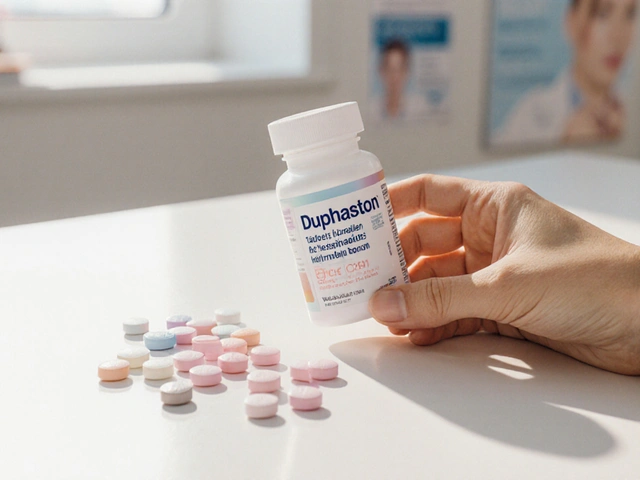Antiplatelet Drug Selection Guide
Select Patient Factors
Dipyridamole is a phosphodiesterase inhibitor used as an antiplatelet agent, typically administered orally (75-200mg four times daily). It works by raising intracellular cAMP, which blocks platelet aggregation. Its half‑life averages 10hours, and it’s often combined with aspirin for stroke prevention. dipyridamole alternatives include newer agents with different safety profiles.
How Dipyridamole Works - Mechanism and Pharmacokinetics
The drug inhibits phosphodiesterase‑5 and blocks the uptake of adenosine, leading to vasodilation and reduced platelet activation. After oral intake, peak plasma concentrations appear in 30-60minutes, and roughly 30% is excreted unchanged in urine. Food slows absorption but does not affect overall exposure.
Primary Clinical Uses
Dipyridamole gained FDA approval in the 1970s for secondary stroke prevention, especially in patients with prior ischemic events who cannot tolerate full‑dose aspirin. It’s also used in stress testing (dipyridamole‑induced myocardial perfusion imaging) and occasionally for preventing thrombosis in vascular grafts.
Key Alternatives in Antiplatelet Therapy
When doctors consider a switch or adjunct therapy, they usually look at the following agents:
- Clopidogrel - a thienopyridine that irreversibly blocks the P2Y12 receptor; taken once daily (75mg); half‑life 6hours; metabolized by CYP2C19.
- Aspirin - an irreversible COX‑1 inhibitor; low dose (81mg) or full dose (325mg); half‑life 15-20minutes; widely available.
- Warfarin - a vitaminK antagonist; oral dose 2-10mg adjusted to INR 2.0‑3.0; half‑life 36-42hours; requires frequent monitoring.
- Ticagrelor - a reversible P2Y12 inhibitor; 90mg twice daily; half‑life 7hours; does not need metabolic activation.
- Heparin - a parenteral anticoagulant (unfractionated or low‑molecular‑weight); dosage based on weight; half‑life 1‑2hours (UFH) or 4‑5hours (LMWH); monitored via aPTT or anti‑Xa.
Side‑Effect Profiles and Safety Considerations
Each drug carries a distinct adverse‑event signature:
- Dipyridamole - headache, dizziness, gastrointestinal upset; rare bleeding when combined with aspirin.
- Clopidogrel - mild bruising, rare severe bleeding, possible resistance in CYP2C19 poor metabolizers.
- Aspirin - gastric irritation, ulceration, increased bleed risk especially at higher doses.
- Warfarin - major bleeding, skin necrosis, numerous drug‑food interactions (e.g., leafy greens).
- Ticagrelor - shortness of breath, bradyarrhythmias, dyspnea.
- Heparin - heparin‑induced thrombocytopenia (HIT), bleeding, osteoporosis with long‑term use.

When to Choose Dipyridamole Over the Others
Clinicians weigh several factors:
- Stroke or TIA history: Dipyridamole + low‑dose aspirin outperforms aspirin alone in several landmark trials (e.g., ESPRIT, CARESS). It’s especially useful when patients have aspirin intolerance.
- Renal function: Dipyridamole is cleared renally; dose adjustment is modest, making it safer than warfarin in mild to moderate renal impairment.
- Bleeding risk: Compared with clopidogrel or ticagrelor, dipyridamole has a lower major‑bleed rate, though the combination with aspirin raises the risk modestly.
- Cost and accessibility: It’s inexpensive and widely available in generic form, whereas newer P2Y12 inhibitors can be costly.
Decision‑Making Table
| Drug | Mechanism | Typical Dose | Half‑Life | Main Indication | Major Side‑Effects |
|---|---|---|---|---|---|
| Dipyridamole | Phosphodiesterase‑5 & adenosine uptake inhibitor | 75-200mg PO q6h | ~10h | Secondary stroke prevention | Headache, dizziness |
| Clopidogrel | P2Y12 irreversible antagonist | 75mg PO daily | ~6h (active metabolite) | ACS, stent thrombosis prophylaxis | Bleeding, resistance |
| Aspirin | COX‑1 irreversible inhibitor | 81-325mg PO daily | 15-20min | Primary/secondary CVD prevention | GI ulcer, bleed |
| Warfarin | VitaminK antagonist | 2-10mg PO daily (INR‑guided) | 36-42h | AF‑related stroke, VTE | Bleeding, food‑drug interactions |
| Ticagrelor | Reversible P2Y12 antagonist | 90mg PO BID | ~7h | ACS, PCI | Dyspnea, bleed |
| Heparin | Antithrombin III activator | Weight‑based IV/SC | 1-2h (UFH) / 4-5h (LMWH) | Peri‑procedural anticoagulation | HIT, bleed |
Practical Tips for Switching or Adding Dipyridamole
- Check baseline platelet function if patient is already on a P2Y12 inhibitor.
- Start with 75mg PO BID, titrating up to 200mg PO QID based on tolerance.
- Monitor for headache; acetaminophen can usually control mild cases.
- When combined with aspirin, use the low‑dose (81mg) formulation to limit gastrointestinal risk.
- Renal dose adjustment: reduce to 75mg QID if eGFR <30mL/min/1.73m².
Related Concepts and Next Topics to Explore
Understanding dipyridamole fits into a larger conversation about antithrombotic strategies. Related areas worth reading next include:
- Dual antiplatelet therapy (DAPT): How aspirin pairs with P2Y12 inhibitors after coronary stenting.
- Anticoagulation in atrial fibrillation: Direct oral anticoagulants versus warfarin.
- Pharmacogenomics of clopidogrel: CYP2C19 testing to predict response.
- Stroke risk calculators: CHADS₂‑VASc and its role in choosing antiplatelet vs anticoagulant therapy.
Frequently Asked Questions
Can dipyridamole be used alone for stroke prevention?
Guidelines recommend dipyridamole in combination with low‑dose aspirin for secondary stroke prevention. On its own, the evidence is weaker and the bleed risk is higher.
How does dipyridamole differ from clopidogrel?
Dipyridamole raises cAMP levels and blocks adenosine uptake, while clopidogrel irreversibly blocks the P2Y12 receptor. Their side‑effect profiles and dosing schedules also differ, making each suited to different clinical scenarios.
Is dipyridamole safe for patients with kidney disease?
It is primarily eliminated by the kidneys, so dose reduction is advised when eGFR falls below 30mL/min/1.73m². It remains safer than warfarin in mild‑to‑moderate renal impairment.
What are the most common drug interactions with dipyridamole?
Aspirin (increases bleed risk), statins (especially simvastatin, which can raise dipyridamole levels), and certain antihypertensives may potentiate vasodilatory effects. Always review the full medication list before starting.
Why might a physician choose ticagrelor over dipyridamole?
Ticagrelor provides faster, more potent platelet inhibition, which is essential after acute coronary syndromes or percutaneous coronary intervention. Dipyridamole’s role is limited to stroke prevention rather than coronary events.
Can dipyridamole cause severe bleeding?
Severe bleeding is uncommon when dipyridamole is used alone. The risk rises when combined with aspirin or other antithrombotic agents, but it remains lower than that of newer P2Y12 inhibitors.






Michael Weber
26 September, 2025 . 23:31 PM
The realm of antiplatelet therapy often masquerades as a simple choice, yet beneath the surface lies a complex ethical landscape. When clinicians favor dipyridamole, they must confront the paradox of its modest efficacy against the specter of patient adherence. One cannot ignore the philosophical weight of prescribing a four-times‑daily regimen to individuals already burdened by polypharmacy. Moreover, the comparative bleeding risk, though lower than some P2Y12 inhibitors, still demands vigilant monitoring. Ultimately, the decision reflects a balance between evidence and the moral imperative to do no harm.
Blake Marshall
3 October, 2025 . 04:01 AM
Yo, I think you’re overthinkin it – dipyridamole actually works fine when you combine it with low dose aspirin, no need for all that deep philosophy. The studies show it cuts stroke recurrence by a decent margin, so it’s not just hype. If u got a patient who can handle four pills a day, go ahead and use it. Definately cheaper than some of the newer P2Y12 drugs.
Daniel Buchanan
9 October, 2025 . 08:31 AM
For anyone weighing dipyridamole against clopidogrel, remember that individual tolerance varies, and shared decision‑making can improve outcomes. It’s helpful to assess headache history, as dipyridamole‑induced headaches are common but manageable with simple analgesics. Also, consider renal function; moderate impairment may warrant dose adjustment. By involving patients in the conversation, clinicians foster adherence and trust.
Lena Williams
15 October, 2025 . 13:01 PM
When you look at the table of antiplatelet agents, dipyridamole stands out not just because of its mechanism but also because of its historical legacy in stroke prevention, a fact that many newer drugs simply can’t claim. Its dual action-blocking phosphodiesterase‑5 and inhibiting adenosine uptake-creates a unique platelet‑inhibitory profile that some clinicians still value, especially in patients who can’t tolerate higher doses of aspirin. However, the four‑times‑daily dosing schedule can be a real pain point, leading to missed doses and potentially reduced efficacy, which is something we need to keep in mind. The side‑effect constellation, dominated by headaches and occasional dizziness, is often cited as a deterrent, yet most patients find the discomfort tolerable with over‑the‑counter analgesics. Cost is another critical factor; generic dipyridamole is cheap, making it attractive in resource‑limited settings where the price of ticagrelor or clopidogrel may be prohibitive. On the other hand, clopidogrel’s once‑daily dosing and overall better tolerance profile give it an edge in many modern protocols, especially after acute coronary events. Some practitioners argue that the modest benefit of dipyridamole over aspirin alone doesn’t justify its complexity, pointing to large trials like ESPRIT that showed only a slight absolute risk reduction. Yet, in patients with a documented aspirin intolerance, dipyridamole plus low‑dose aspirin becomes a viable alternative that many guidelines still endorse. Renal clearance is primarily via the kidneys, so in patients with moderate impairment you’ll want to cut the dose, but it’s still safer than warfarin in terms of monitoring burden. Moreover, the drug’s half‑life of roughly ten hours means steady‑state concentrations are achieved relatively quickly, which can be advantageous when rapid platelet inhibition is desired. From a pharmacoeconomic standpoint, the low acquisition cost can offset the potential need for additional visits to manage side effects, a trade‑off that health systems must evaluate. Clinically, the decision often hinges on individual risk profiles-patients with high bleeding risk might benefit from dipyridamole’s lower major bleed rates compared with potent P2Y12 inhibitors. Conversely, in the setting of acute coronary syndrome, the evidence leans heavily toward ticagrelor or clopidogrel because of their superior outcomes in large randomized trials. It’s also worth noting that dipyridamole’s role in stress testing provides an extra diagnostic utility that’s unique among antiplatelet agents. In practice, the choice is rarely black‑and‑white; it’s a nuanced balancing act between efficacy, safety, convenience, and cost. Ultimately, the best drug is the one the patient can and will take consistently, and that principle should guide our prescriptions.
Sierra Bagstad
21 October, 2025 . 17:31 PM
Indeed, the pharmacodynamic nuances you highlighted explain why dipyridamole maintains a niche role despite its dosing inconvenience; its platelet‑cAMP elevation remains a distinct therapeutic pathway unmatched by P2Y12 antagonists. Clinical guidelines still list it as an option for secondary stroke prevention when aspirin tolerance is an issue.
Alan Kogosowski
27 October, 2025 . 21:01 PM
From a mechanistic perspective, dipyridamole’s inhibition of both phosphodiesterase‑5 and adenosine uptake creates a synergistic increase in intracellular cyclic AMP, which in turn attenuates platelet aggregation more subtly than the irreversible P2Y12 blockade seen with clopidogrel or ticagrelor. This biochemical subtlety translates clinically into a modest but statistically significant reduction in recurrent ischemic events, particularly in patients with a history of non‑cardioembolic stroke. Nevertheless, the requirement for four daily doses can compromise adherence, a factor that is often under‑appreciated in the design of phase III trials. Renal excretion accounts for roughly 30% of the drug’s clearance, meaning that patients with eGFR below 30 mL/min/1.73 m² may need dose reduction to avoid accumulation and related side‑effects. Moreover, the drug’s interaction profile is relatively benign, with no major cytochrome P450 involvement, which simplifies co‑administration with statins or antihypertensives. In contrast, clopidogrel’s reliance on CYP2C19 activation renders it less effective in poor metabolizers-a genetic consideration that has prompted the development of genotype‑guided therapy algorithms. Ticagrelor, while not requiring metabolic activation, carries a higher incidence of dyspnea, a symptom that may limit its tolerability in patients with underlying pulmonary disease. Cost considerations favor dipyridamole in many health systems, as generic formulations are often markedly cheaper than brand‑name P2Y12 inhibitors, although insurance formularies can sometimes skew availability. Ultimately, the choice among these agents should be individualized, weighing the relative importance of efficacy, safety, dosing frequency, renal function, pharmacogenomics, and economic factors.
Ben Lee
3 November, 2025 . 01:31 AM
I agree that tailoring therapy to the patient’s specific context is key; for someone who struggles with multiple daily pills, clopidogrel’s once‑daily dosing might outweigh dipyridamole’s cost advantage. At the same time, if a patient has a known CYP2C19 loss‑of‑function allele, dipyridamole offers a reliable alternative without the need for genetic testing.
Stacy Whitman
9 November, 2025 . 06:01 AM
Our healthcare system should prioritize home‑grown treatments that are affordable for American families. Importing expensive foreign drugs only widens the gap between the rich and the poor.
Kim and Lin
15 November, 2025 . 10:31 AM
While dipyridamole has its place, we must push for broader insurance coverage so patients don’t have to choose between cost and efficacy 😊. It's frustrating when bureaucratic hurdles limit access to proven therapies.
Kemari Nielson
21 November, 2025 . 15:01 PM
Dipyridamole remains a cost‑effective option for secondary stroke prevention.
Steve Helsel
27 November, 2025 . 19:31 PM
Sure, if you don’t mind the headache side‑effects and the four‑times‑daily schedule, it’s "cost‑effective". Otherwise, the newer P2Y12 inhibitors are just easier to manage.
Steve Moody
4 December, 2025 . 00:01 AM
Esteemed colleagues, let us consider the empirical data, which unequivocally demonstrates that dipyridamole, when combined with low‑dose aspirin, yields a relative risk reduction of approximately 15 % in recurrent ischemic events; however, this benefit must be weighed against a modest increase in headache incidence, a trade‑off that is, in my opinion, acceptable for many patients, particularly those with aspirin intolerance; furthermore, the pharmacoeconomic analyses reveal that the generic formulation of dipyridamole is substantially less costly than branded P2Y12 inhibitors, thereby presenting a compelling argument for its inclusion in formulary decisions, especially within resource‑constrained healthcare settings.
Adrian Hernandez
10 December, 2025 . 04:31 AM
While the “data” seems solid on the surface, one must ask who profits from pushing dipyridamole as the go‑to drug; pharmaceutical lobbyists have a history of shaping guidelines to their advantage, and the subtle inclusion of hidden clauses in clinical trial agreements is no secret. It’s prudent to remain skeptical of any single‑source recommendation that appears too tidy.
duncan hines
16 December, 2025 . 09:01 AM
Oh, the drama of choosing a pill! You think it’s just about numbers, but the real battle is in the boardroom where execs decide which drug gets the spotlight. Dipyridamole may be the underdog, but its “heroic” comeback in low‑cost markets is a story worth watching, even if a few typos slip into the press releases.
Mina Berens
22 December, 2025 . 13:31 PM
Honestly, I’ve seen patients do fine on dipyridamole, especially when they’re motivated 🌟. It’s not the flashiest drug, but it gets the job done for the right crowd. Just remember to monitor those headaches! 👍